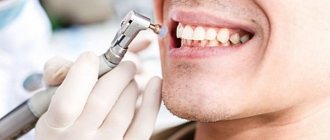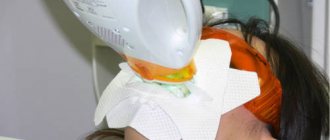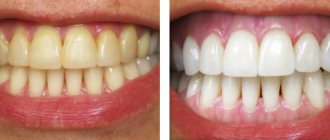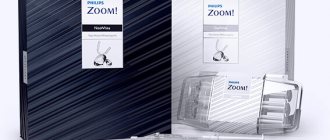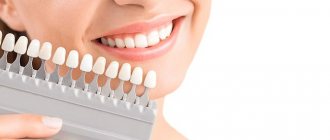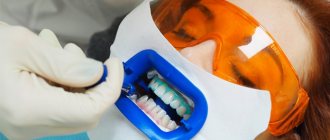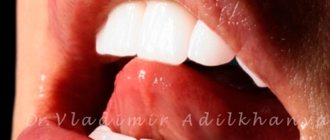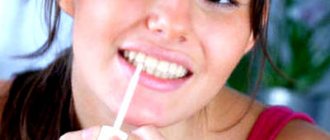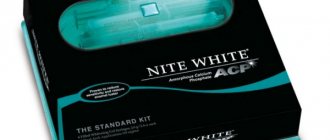System Features
To lighten teeth, a gel based on 35% hydrogen peroxide and a special lamp that generates light in the blue spectrum are used. Under the influence of high-frequency light waves, active oxygen is released from the gel, which penetrates into the deep layers of enamel and discolors accumulated pigments. The device’s lamp combines LED (Light Emitted Diode) technologies without heating and halogen light (Light Bridge) to enhance the effect. A complex system for filtering the supplied light includes special optical fibers and lenses, and protective coatings. 12 stages of protection allow you to obtain an output light flux with a wavelength of 520 nm. This is a cool range that is safe for enamel. The beam temperature is no more than 38 degrees. Unlike ZOOM whitening, there is no harmful ultraviolet radiation, which causes heating of dental tissues and increases tooth sensitivity. The procedure does not have a negative effect on the gums and teeth.
KonevaSvetlana Sergeevna
Dental hygienist, 5 years of experience
Specialist in safe whitening and color restoration of teeth enamel using the American Amazing White and Beyond Polus systems.
Make an appointment
“Beyond Pole” is an improved professional whitening system with expanded functionality. Unlike other devices, it has several operating modes. The light intensity is selected for each clinical case. Individual settings allow for gentle teeth whitening even with enamel damage or intense pigmentation. In the Beyond Polus system, the whitening gel is pre-mixed with a specially developed composition that neutralizes the harm of hydrogen peroxide directly during the procedure. The remineralizing components of the composition strengthen the enamel and reduce its sensitivity.
Despite the safety of Beyond Polus, violation of the technique can provoke demineralization of the enamel or “over-whitening” (an unnatural white tint). It is important to take seriously the issue of choosing a clinic and specialist. In our Center, the procedure is carried out by experienced hygienists who strictly follow the protocol. An individual regimen will be selected for you depending on the permeability of the enamel, the degree of staining, taking into account the problem that led to the need for teeth whitening.
What is cold teeth whitening?
Cold bleaching is a type of photo-bleaching systems that involve the use of a bleaching gel in combination with light exposure, acting as a catalyst. Unlike the most popular ZOOM photo whitening, which uses ultraviolet or LED lamps with air-cooled teeth, cold whitening systems use halogen blue light. The latter does not have a heating effect, which significantly reduces the unpleasant and sometimes even painful sensations from the procedure.
Benefits of Beyond Polus whitening
The cold whitening technique has undergone numerous tests and is found to be effective and completely safe for health.
- Effective Whitening effect up to 10 tones depending on the initial situation. The result lasts up to 5 years if the recommendations are followed.
- Safe The cold light system in the lamp and the special gel composition ensure gentle whitening without tissue burns or tooth sensitivity.
- Fast The procedure lasts 30 minutes - 3 illumination sessions of 10 minutes each. Just half an hour during one visit for a snow-white smile.
- Comfortable Does not cause pain during the procedure. Individual settings are selected based on the degree of tooth sensitivity.
Beyond Polus is one of the safest whitening systems
Does not involve harmful ultraviolet or infrared radiation. Does not cause overheating of dental tissues, burns of mucous membranes and unnecessary tanning around the lips. The optimal range of light flux, individual settings, and the use of gel with protective components make the procedure as gentle as possible. Suitable for the most sensitive teeth.
Levin Dmitry Valerievich Chief physician and founder of the Doctor Levin center
Types of lamps
Domestic dentists more often use stationary office lamps:
• LED TE-600. Compact LED device with two intensity modes. Cold light works on any lightening composition.
• Double White. Cold LED light without ultraviolet affects the dentition individually. You can install a program that monitors the progress of the procedure.
• C–Bright–II. The device is equipped with light beam intensity modes, a timer, a display and a sound signal.
• Beyond Polus. The whitening source is located at the back of the lamp. This ensures neutralization of UV fluxes and uniform coverage.
• Beyond Power Whitening System. Powerful lamp system that reduces the whitening procedure to 30 minutes.
In world dentistry, systems that include a light device are used to whiten teeth. Beyond Polus, Luma Cool and Amazing White are popular in the domestic market.
Preparing for whitening
Before lightening, the dentist prepares the patient’s oral cavity:
1. After a thorough examination, it eliminates inflammatory foci and normalizes periodontal tissue.
2. Removes rocky deposits and plaque. The procedure enhances the effect of the lightening composition and improves the final result.
3. Evaluates the color of teeth according to the international Vita shade scale. Selects the required tone with the patient.
During the procedure, the mucous membrane of the patient’s gums and cheeks is protected with a retractor, which prevents the ingress of gel.
Stages of the procedure
The cold light whitening technique is the same in all cases, regardless of the type of lamp:
1. The lightening composition is evenly distributed over the surface of the dentition.
2. Light rays are directed to the smile area. The average exposure lasts 10–15 minutes.
3. After the dentist evaluates the result, the procedure is stopped or continued.
4. At the end of the event, the remaining composition is removed.
If the patient is not satisfied with the result, then a repeat session is carried out after 7 – 10 days.
Expected effect
Dentists testify to a large tonal range of lightening, reaching 10 tones. If the result is unsatisfactory, the procedure is repeated, increasing the number of approaches to light exposure.
With natural yellow or gray teeth, the desire to achieve a snow-white shade is difficult or impossible.
The lightening result lasts for 12 months, after which the procedure is repeated.
Indications
Cold whitening with a Beyond Polus lamp is performed in cases of tooth discoloration due to various factors
The main reasons why patients come to our Center:
- Taste preferences - color changes as a result of frequent consumption of coloring products, smoking
- Age-related changes - the enamel becomes thin, opaque, darkens as a result of the production of secondary dentin
- Fluorosis is the formation of colored spots or stripes on the enamel as a result of an excess of fluoride in the body
- Tetracycline teeth - stains due to uncontrolled antibiotic use in utero or childhood
Gentle on enamel and gums, does not cause pain
Experts say that teeth whitening with cold light eliminates the possibility of injury, overheating and overdrying of hard tissues, as well as increased enamel sensitivity after the procedure. When carrying out manipulations there is no risk of burns or irritation of the mucous membrane.
Cold whitening is a gentle method
“I’ve been wanting to try cold whitening for a long time. True, because of the name, I was afraid that the cold would set my teeth in the process, but it turned out that this was not the case at all. During the procedure, I very carefully monitored the sensations that arose: when the gel was applied, I felt a slight tingling sensation, but I did not have any direct pain or cramps. Everything is tolerant and acceptable! On the first day, of course, my teeth ached, there’s no way around it, but less than with chemical whitening, which I did before. By the second day I already felt completely fine.”
Viki_Niki, review from otzovik.com
Stages of the procedure
The procedure itself is carried out in one visit for half an hour. If plaque, stones on the teeth, or inflammatory processes in the oral cavity are detected, preparatory measures are carried out first
Preparation
Whitening is preceded by a preparatory stage, which is aimed at eliminating obstacles to the procedure and ensuring the proper result. Mandatory includes an examination of the oral cavity and diagnostics. If necessary, the following is prescribed:
- professional teeth cleaning from soft and hard plaque
- treatment of dental diseases
- remineralization of enamel to strengthen it
3-7 days before whitening, it is recommended to brush your teeth only with white toothpaste, and also to exclude from your diet foods that can stain the enamel (coffee, wine, carbonated drinks, ketchup, carrots, beets, chocolate).
How is whitening performed?
- Preparation The patient's eyes are protected with special glasses. A retractor is fixed in the mouth. The lips are lubricated with cream, and a liquid rubber dam is applied to the gums to protect the mucous membrane from the chemical components of the drug.
- Whitening Teeth are coated with 35% hydrogen peroxide gel with protective components. The composition is illuminated with a Beyond Polus lamp for 10 minutes. The stage is repeated 3 times; before each application of the gel, the previous layer is removed.
- Strengthening enamel A remineralizing agent containing calcium, phosphorus and other components is applied to the teeth. Prevents enamel fragility, helps strengthen it, protects teeth from sensitivity.
Whitening with chemicals at home
If the enamel darkens, you don’t have to run to the dentist; you can use lightening methods at home:
- Mouthguards. In this case, a certain gel is purchased that contains a low concentration of hydrogen peroxide and carbide. These components are placed in the cavity of the mouthguard, which is pre-selected according to the size of the jaw. It is put on the teeth and the person walks with it for a certain time. This method is considered the most harmless.
- The use of special strips and pencils. They contain chemical compounds, you can purchase them yourself. Before starting use, read the instructions carefully and follow them strictly. If there are contraindications, then under no circumstances use chemical pencils and lightening strips. It is worth warning immediately that the whitening effect appears gradually, but does not last long. Whitening strips are used as an additional way to lighten tooth enamel. They are convenient to carry with you and apply after eating coloring products.
- Pastes with whitening effect. There are two types of such pastes. The first is a paste that independently removes dark pigment from the surface of the teeth. Such pastes contain a high percentage of abrasiveness and only remove dark stains and a little tartar. Contraindications to its use are tooth hypersensitivity and rapid wear of enamel. The second is a paste that has brightening properties. The basis of such pastes is carbide peroxide. Such pastes are the most effective and safe for tooth enamel. But the main disadvantage of using such pastes is the short-term whitening result.
For all whitening methods, there are certain rules that must be followed after the procedure. You should not eat food or drinks that have coloring in the first days. Namely berries, mustard, tea, coffee, etc. Avoid smoking. In the future, take good care of your mouth. Speaking of professional cleaning, it should be done twice a year. Use gentle whitening methods at home to ensure long-lasting results.
What is the best teeth whitening? There is no definite answer to this question, since everything is individual.
Contraindications
Beyond Polus technology is safe for enamel, but some patients should refrain from whitening procedures, not only with this system
Among the absolute contraindications:
- age up to 16 years
- allergy to the components of the drug
- period of pregnancy or lactation in women
- serious health problems (malignant neoplasms, pathologies of the circulatory, cardiovascular, immune systems)
Relative restrictions that need to be corrected before the whitening procedure include:
- open caries, pulpitis
- periodontal tissue diseases
- enamel cracks
- outdated fillings with poor fit
Professional laser method
Laser whitening is performed in the dentist's office and is not much different from photo whitening. The difference is that the gel applied to the surface of the teeth begins its action not under the influence of light, but under the influence of a laser. Many experts recognize this method as the best among other types of whitening. But patients themselves leave different reviews regarding laser lightening. But in any case, a consultation with a dentist is necessary, since the laser method also has a number of contraindications.
How to prolong the whitening effect
On average, after bleaching Beyond Polus, enamel remains white for one year. However, this indicator depends on subsequent oral care and compliance with specialist recommendations:
- during the first 3-4 hours after the session you cannot eat;
- It is advisable not to smoke for a day;
- women should refrain from applying bright lipstick to their lips for three days;
- for two weeks, exclude foods that can stain the enamel - chocolate, coffee, wine, beets, carrots, carbonated drinks;
- Brush your teeth regularly - at least twice a day with a special toothpaste prescribed by your doctor.
The e-Bright system specially developed by Beyond for home use allows you to significantly extend the whitening effect. It complements the desk procedure and is aimed at consolidating the results obtained. The set includes a gel and a dental guard with built-in LED lights. The home course should begin 2-3 weeks after the clinical course. The idea is to apply the drug to the teeth and wear the mouth guard for 20 minutes. Performed once a day for 8-10 days.
Allows you to lighten teeth by 6–10 shades
Teeth whitening without heat or laser is safer than with it. However, the effect of using this technology will not be so impressive: not 8–12, but 6–10 tones. The maximum positive result can be achieved if darkening or yellowing of the enamel was caused by smoking, consumption of food and drinks with dyes, or age-related changes.
Some doctors do not advise teeth whitening with cold light if the enamel has a natural gray tint, because then the maximum that can be achieved will be only 2-3 tones.
A smile can be lightened by 6–10 tones
Alternative whitening systems
Our Center uses another safe teeth lightening technology - Amazing White, also from an American manufacturer. Like Beyond Polus, cold whitening technology is used. But Amazing White uses a gel with a lower concentration of the active substance - 16%. The lightening intensity is correspondingly lower - by 3-6 tones. Since our Center specializes in implantation and surgery, this system is ideal for teeth whitening even in the postoperative period without irritating the mucous membranes. Suitable when you want to get an immediate aesthetic effect soon after surgery.
We do not use the advertised Zoom technology, despite the same effectiveness as Beyond Polus. The system is not safe for tooth enamel. The technology is based on a gel with a peroxide concentration of 25% and a UV lamp with thermal radiation. Overheating of the enamel-dentin layer is possible, which is accompanied by prolonged increased sensitivity of the teeth. In addition, preparation for the procedure requires special scrupulousness in order to protect the mucous membranes from burns and prevent unnecessary tanning around the lips.
What is the difference between hygienic cleaning and bleaching
Hygienic cleaning is carried out using a special ultrasonic scaler or Air Flow device. It allows you to eliminate food debris, as well as get rid of hard and soft plaque on your teeth. Your teeth may appear lighter after brushing. This is true, but the point is not the whitening effect, but the fact that the top yellow plaque has been cleaned off the enamel. Therefore, you can see the teeth in their natural color. Professional cleaning is very important for health, as it not only reduces the likelihood of caries, reduces bleeding gums, but also helps improve the body’s immunity as a whole. In addition, it must be carried out before any bleaching.
Whitening itself does not provide any health benefits and is a purely cosmetic procedure. But thanks to it, you can change the natural color of your teeth by 8-10 shades and get a radiant smile no worse than that of TV stars.
Bleaching costs more than cleaning and has various limitations. For people with very sensitive enamel, it is better to opt for professional hygiene.
